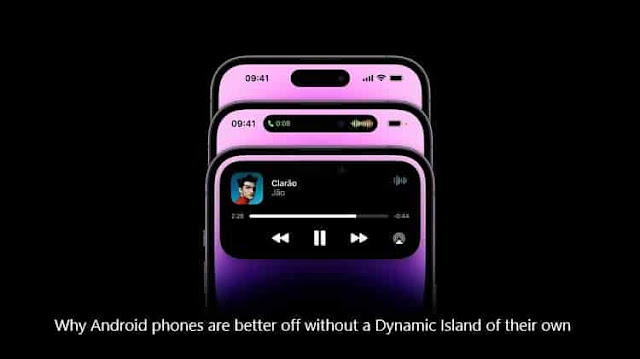Why Android phones are better off without a Dynamic Island of their own
The pill-shaped cut-out that Apple has incorporated in its new iPhone 14 Pro series is more recognizable than the 48-megapixel main camera or the A16 chipset. The Dynamic Island feature, which has been making the rounds in the tech community for weeks, appears to have the potential to 'inspire' Android phone manufacturers to implement their own notch-based indicator + multitasking feature.
But is that actually required?
Both Xiaomi and Realme, two well-known smartphone manufacturers that primarily target the entry-level and mid-range markets, may be thinking of integrating a variation of Apple's Dynamic Island on their own devices. A Realme blog post urges readers to "Can you picture what if Realme UI incorporated a software technique to turn the camera cutout into a multifunctional feature?" implying the feature is possibly in the works.
In the meantime, Xiaomi President Lu Weibing reportedly asked followers on Weibo if they "truly need a smart island?" Remember that Dynamic Island is here because Apple cannot remove a notch, even if users may be eager to try the popular Apple software function on their phone.
Why Apple has a notch even now
A cut-out above the display is necessary for the front camera and IR emitters that power Apple's FaceID biometric verification system because they both need to point directly at people. The new iPhone 14-series implements a circular notch for the camera and an adjacent pill for the IR system, as opposed to the trapezoidal notch we have been seeing since the iPhone X.
Dynamic Island's ability to dynamically morph into larger, rectangular shapes to offer more contextual information, such as incoming calls and running programs, is what makes programs Dynamic Island what it is. This ability is powered by software.
In all honesty, this is a fantastic approach that allows Apple to both hide the notch in many situations and still make it enjoyable and occasionally beneficial. Dynamic Island may not be an intelligent concept for all phones, despite this.
For developers, Android's notch UIs might be a nightmare.
To start, Android phones' displays already exist in a wide range of sizes, shapes, resolutions, and notch cutout configurations. For this reason, you probably won't see the same amount of developer support for third-party apps that deliver alerts and other features via a new UI element. Imagine needing to create a new interactive UI extension for a few different phones for Spotify, Otter, or Snapchat.
Although only two models at this time support the Dynamic Island, that still accounts for half of Apple's iPhone 14 lineup, and the Island is probably a feature we will see in future iPhones as well. The implementation is simpler on Apple devices because there are significantly fewer iPhone screen variations than on Android devices. Because of this, it makes sense for iOS developers to devote their work to maintain the feature.
The notification panel on Android provides more accessibility.
In recent software revisions, Android's notification panel has seen some pleasant enhancements that have made it possible for users to manage interactive mini-widgets like Spotify's music player with ease.
Any Android phone's notification panel may be pulled down to reveal interactive notifications, which are placed significantly lower so your thumb can easily access them. You can even scroll between multiple interactive messages that are displayed in the panel at once. Apple's Dynamic Island, meanwhile, has a two-app maximum.
The Dynamic Island appears strange in the sun.
Several tweets have surfaced in recent weeks that demonstrate how successfully the Dynamic Island implementation hides the notch—but only while you are inside and shielded from any glare from the sun. The Dynamic Island's darker UI quickly becomes more difficult to notice in bright light, leaving behind the i-shaped notch's remnants.
Other issues
A punch-hole for the front camera that is centered on the top of the screen is present in a number of Android smartphones. Every time you want to take a selfie or start a video chat, you'll have to take the extra effort of cleaning your camera because a UI designed around this notch and taking regular inputs is going to leave smudges on the front camera.
Let's not forget that Apple cannot yet remove the notch, which is why the Dynamic Island feature is present. However, neither a notch on top of the screen nor a UI around it is necessary for Android phones, the majority of which rely on fingerprint sensors for verification.
